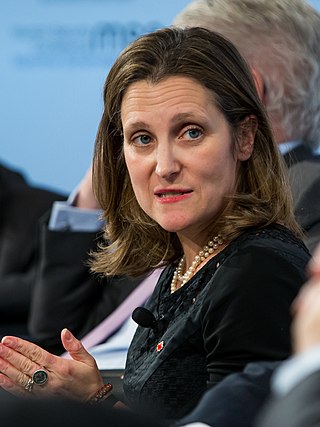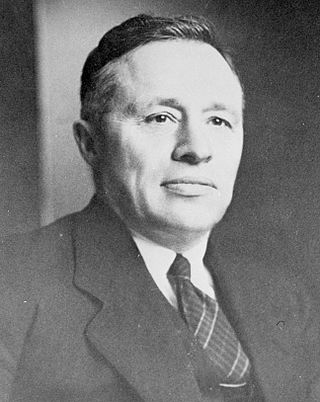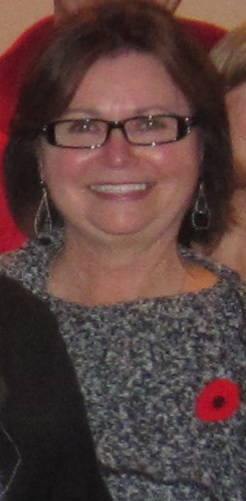
A prime minister or chief of cabinet is the head of the cabinet and the leader of the ministers in the executive branch of government, often in a parliamentary or semi-presidential system. Under those systems, a prime minister is not the head of state, but rather the head of government, serving as the principal administrator under either a monarch in a monarchy or a president in a republican form of government.

The prime minister of Australia is the head of government of the Commonwealth of Australia. The prime minister heads the executive branch of the federal government of Australia and is accountable to federal parliament under the principles of responsible government. The prime minister is the chair of the federal cabinet and the national cabinet and a member of the federal executive council. The current prime minister is Anthony Albanese of the Australian Labor Party, who assumed the office on 23 May 2022.

The prime minister of Canada is the head of government of Canada. Not outlined in any constitutional document, the office exists only per long-established convention. Under the Westminster system, the prime minister governs with the confidence of a majority of the elected House of Commons; as such, the prime minister typically sits as a member of Parliament (MP) and leads the largest party or a coalition of parties. The prime minister is appointed by the monarch's representative, the governor general, and, as first minister, selects other ministers to form the Cabinet and chairs it. Constitutionally, executive authority is vested in the monarch, but, in practice, the powers of the monarch and governor general are nearly always exercised on the advice of the Cabinet, which is collectively responsible to the House of Commons. Canadian prime ministers are appointed to the Privy Council and styled as the Right Honourable, a privilege maintained for life.

The premier of South Australia is the head of government in the state of South Australia, Australia. The Government of South Australia follows the Westminster system, with a Parliament of South Australia acting as the legislature. The premier is appointed by the governor of South Australia, and by modern convention holds office by virtue of their ability to command the support of a majority of members of the lower house of Parliament, the House of Assembly.

Politics of Saint Lucia takes place in the framework of an independent parliamentary democratic constitutional monarchy, with King Charles III as its head of state, represented by a Governor General, who acts on the advice of the prime minister and the cabinet. The prime minister is the leader of the majority party of the house, and the cabinet conducts affairs of state. The Governor General exercises basically ceremonial functions, but residual powers, under the constitution, can be used at the governor general's discretion. The actual power in St. Lucia lies with the prime minister and the cabinet, usually representing the majority party in parliament.

The prime minister of New Zealand is the head of government of New Zealand. The incumbent prime minister, Christopher Luxon, leader of the New Zealand National Party, took office on 27 November 2023.
In a parliamentary or semi-presidential system of government, a reserve power, also known as discretionary power, is a power that may be exercised by the head of state without the approval of another branch or part of the government. Unlike in a presidential system of government, the head of state is generally constrained by the cabinet or the legislature in a parliamentary system, and most reserve powers are usable only in certain exceptional circumstances.
A motion or vote of no confidence is a formal expression by a deliberative body as to whether an officeholder is deemed fit to continue to occupy their office. The no-confidence vote is a defining feature of parliamentary democracy which allows the elected parliament to either affirm their support or force the ousting of the cabinet. Systems differ in whether such a motion may be directed against the prime minister only or against individual cabinet ministers.
A constitutional convention is an informal and uncodified tradition that is followed by the institutions of a state. In some states, notably those Commonwealth of Nations states that follow the Westminster system and whose political systems derive from British constitutional law, most government functions are guided by constitutional convention rather than by a formal written constitution. In these states, actual distribution of power may be markedly different from those the formal constitutional documents describe. In particular, the formal constitution often confers wide discretionary powers on the head of state that, in practice, are used only on the advice of the head of government, and in some cases not at all.

The deputy prime minister of Canada is a minister of the Crown and a member of the Canadian Cabinet. The office is conferred at the discretion of the prime minister and does not have an associated departmental portfolio. Canadian deputy prime ministers are appointed to the Privy Council and styled as the Honourable, a privilege maintained for life.

The premier of Ontario is the head of government of Ontario. Under the Westminster system, the premier governs with the confidence of a majority the elected Legislative Assembly; as such, the premier typically sits as a member of Provincial Parliament (MPP) and leads the largest party or a coalition of parties. As first minister, the premier selects ministers to form the Executive Council, and serves as its chair. Constitutionally, the Crown exercises executive power on the advice of the Executive Council, which is collectively responsible to the legislature.

Thomas Walter Scott was the first premier of Saskatchewan from 1905 to 1916. Scott was Saskatchewan's second longest-serving Premier, serving one continuous term from 1905 to 1916). He led the Saskatchewan Liberal Party in three general elections, winning all three with majority governments before retiring. He was the first of six Liberal Premiers to date. He was succeeded by William Melville Martin. Scott was also the minister of various departments during his tenure as premier. Prior to the creation of Saskatchewan in 1905, Scott was a Member of Parliament in the federal House of Commons of Canada, elected in the general elections of 1900 and 1904.
In Canada, a premier is the head of government of a province or territory. Though the word is merely a synonym for prime minister, it is employed for provincial prime ministers to differentiate them from the prime minister of Canada. There are ten provincial premiers and three territorial premiers. In most provinces and all territories, these persons are styled the Honourable only while in office, unless they are admitted to the King's Privy Council for Canada, in which case they retain the title even after leaving the premiership. In Nova Scotia and Alberta, former premiers are honorary members of the provincial Executive Council and thereby retain the style the Honourable for life.

James Garfield Gardiner was a Canadian farmer, educator, and politician. He served as the fourth premier of Saskatchewan, and as a minister in the Canadian Cabinet.

Judy May Foote is a former Canadian politician who served as the 14th lieutenant governor of Newfoundland and Labrador from 2018 to 2023. She was the first woman to hold the position.
In Australian political and constitutional terminology, a caretaker government is a government of Australia from when the House of Representatives is dissolved by the Governor-General prior to a general election to a period after the election, until the next ministry is appointed. A caretaker government is expected to conduct itself in accordance with a series of well-defined conventions administered by the Department of the Prime Minister and Cabinet, but there is no law compelling the caretaker government to do so.
A prime minister–designate or premier–designate is the person who is expected to succeed an incumbent as prime minister, or premier, as the result of a general election, winning the leadership of a currently governing party, or being named by the head of state to form a new government.
Prorogation is the end of a parliamentary session in the Parliament of Canada and the parliaments of its provinces and territories. It differs from a recess or adjournment, which do not end a session; and differs from a complete dissolution of parliament, which ends both the session and the entire parliament, requiring an election for the House of Commons in the bicameral federal parliament and the singular legislative chamber of the unicameral provincial parliaments.
In Malaysian political and constitutional terminology, a caretaker government is a government of Malaysia during a period that starts when the parliament is dissolved by the Yang di-Pertuan Agong prior to a general election, and continues for a period after the election, until the next cabinet is appointed. A caretaker government is expected to conduct itself in accordance with a series of well-defined conventions that are administered by the Prime Minister's Department, although there is no law compelling the caretaker government to do so.











